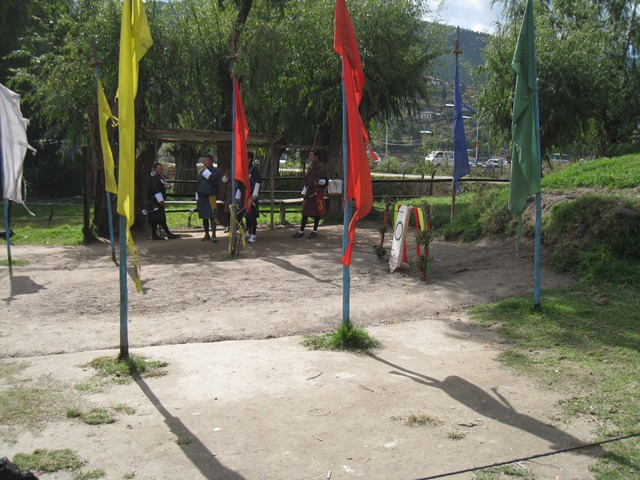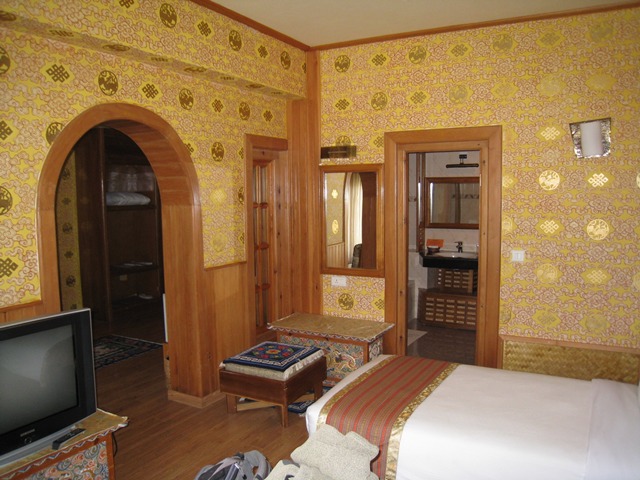Gross National Happiness and Marijuana
I flew from Bangkok to Bagdogra, India, which took two and a half hours. We spent 30 minutes in India before taking off for my final leg to Paro, Bhutan, now only 30 more minutes away.
After a very exciting approach and landing I got ready to deplane. I walked through the door and the sun hit me. My eyes adjusted and I saw amazing mountain ranges all around me. Then I saw the airport, an architectural work that instantly consumed me with the Bhutan vibe. I’m not sure if it was the almost 32 hours it took to get here with little to no sleep, or the various glasses of wine I had on my four flights. But I was overcome with emotion and could not walk down the stairs until I attempted to capture this image with my camera, if nothing more than to remind me of this single moment.
Instead of the normal mad rush to get through immigration before a large line formed, everyone took their time, soaking in that initial moment, burning 10 to 20 pictures on their memory card before even leaving the tarmac. We all came here, because here is Bhutan.
I went through immigration and they double checked my passport, visa, route permits, and asked if I had any cigarettes. Tobacco is illegal in Bhutan and possession of a single cigarette is a felony. I converted some US dollars in to Bhutanese Negultrums, got my luggage, and then found my guide and driver. Both my guide and driver were amazing and it really added to my experience. He said he was glad I read the information on appropriate dress and we took off in a nice Hyundai Tucson, heading out of Paro towards Thimphu. In Bhutan you are required to wear long pants (no shorts) and a long sleeve shirt (preferably collared). While native Bhutanese men and women must wear the traditional dress.
On the way out of town we stopped to watch an archery practice, which is their national past time. It looked to be about the distance of a football field. They seemed to have a lot of confidence in their opponents as they stood quite close to the target as incoming arrows appeared to come right out of the sky.
Bhutan is experiencing a lot of growth and it is nice to see that they are not only staying with the traditional architecture but also using traditional methods in building them. Except they are now hiring people from India to build them, kind of like our Mexican day labors.
It took about an hour to get from Paro to Thimphu. Thimphu is the capital of Bhutan and it is the only capital in the world that does not have a stop light, instead they have a single intersection where someone directs traffic.
Because Bhutan is a Buddhist country, they don’t kill any annals. This means I would mostly be eating rice, noodles, and vegetables, all containing various levels of chilies, they put chilies on everything. My first experience with Bhutanese cuisine was at lunch right on the main road.
It was at this point I also got to try my first Bhutanese beer, Druk 11000. No, I did not misspell that, it really is "Druk" and not "Drunk", even though the beer is 8% alcohol. Bhutanese refer to their country as "Druk Yul" which means "Land of the Thunder Dragon", and Druk means Dragon. "Dragon 11000" uses recycled bottles so sometimes it comes in a green bottle, sometimes a clear one, and sometimes a brown one. It was really good, not just because of its refreshing tasty flavor, but also because it was one of the few things that came without chilies in it. Another nice thing, at least for the first day or so, is that because you are over 10,000 feet you really only need to buy one of these big beers.
While most adults have archery for entertainment, most kids play darts, and we came across a championship tournament. The distance is shorter and the target is smaller, but the point just as sharp and they stand just as close.
We then stopped at the Zilukha nunnery (female monks) where they were in the middle of their three hour prayer. This is where I got a little disappointing news that will also impact you, the reader. In Bhutan you are not allowed to take any pictures or video inside of temples, monasteries, or Dzongs (government buildings). In the ones in the cities of Paro and Thimphu, where any foreigner is allowed, you have to leave your camera outside along with your shoes. Outside of these two cities all foreigners are required to be escorted by a guide who can monitor this, so you only have to leave your shoes outside.
Afterwards we went to the market, however because they are mostly vegetarian, it was mostly produce and vegetables, and hundreds of chilies.
You can only cook rice, noodles, and vegetables so many ways, so they have a lot of different spices to add.
Fish, well kind of fish, these are dried and shipped in from India. India is one of their main trading partners. In fact Bhutan’s biggest export is electricity, powered by the many rivers coming down out of the mountains, which they sell to India. The Buddhists have a loophole here in that while they cannot kill any animal, they can still eat it if someone else kills it. But again I’m not sure these fish are actually fish anymore.
Dried pork skin, same loophole, same question as to whether it ever was even a pig to begin with.
I did not make any purchases at the market so we went to see the Tashichhodzong where the country is ruled administratively by King Jigme Khesar Namgyel Wangchuk and spiritually by the Supreme Religious Leader, Je Khenpo. Bhutan is less concerned about what it has or does not have, and Gross National Product (GNP) has little meaning compared to just about every other country. Bhutan is more interested in the secular and spiritual well being of its people, basically are its people happy. They created the Gross National Happiness (GNH) based on four pillars: equitable and sustainable socio-economic development, preservation and promotion of cultural values, conservation of the natural environment, and establishment of good governance. It is clearly working, the people I met are very happy and giving.
How happy are the people in Bhutan? So happy that marijuana pretty much grows wild everywhere and they don’t smoke it or even make brownies with it. They do however feed it to their pigs as it keeps them happy and more importantly, quiet.
Currently the largest Buddha is in Hong Kong, however that is only for a few more months until they complete the one we are heading to see in Bhutan, which will soon take over that title.
The view of Thimphu below was breathtaking and I felt something that would reoccur many times on this trip. How did I get so lucky, so fortunate, to get to experience this life, my life.
On the way back to the hotel we stopped at Memorial Chorten, where everyday people come to spin prayer wheels and give prayers.
I told my guide I was happy and did not need to pray for anything else. And that’s when he told me that they are not praying for themselves, but for others who have not been as fortunate. At first it was a foreign concept, they finish a long day of work and before going home to their family they come spin a wheel and pray for people they do not even know. It was the first of many lessons on this trip and to make up for lost time I went around twice. Keeping in mind that my guide said you always go clockwise.
What an amazing first day in Bhutan. It was emotional when I arrived after such a long journey and again emotional at the end of the day when I found myself spinning a prayer wheel. All the reasons for this journey were starting to manifest themselves. I checked in to my hotel for the night and it was beautiful, just shouting with the Bhutan vibe. It would be one of the nicest places I would stay on this trip. I knew as we headed out in to the Himalayan foothills I would soon miss things like electricity, cable TV (even though it was speaking foreign to me), and of course that warm flushable toilet.
VIDEO: Day 1 - Thimphu




























